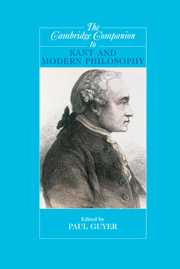Book contents
- Frontmatter
- Introduction: The starry heavens and the moral law
- 1 “A Priori”
- 2 Kant on the perception of space (and time)
- 3 Kant’s philosophy of mathematics
- 4 Kant on a priori concepts: The metaphysical deduction of the categories
- 5 Kant’s philosophy of the cognitive mind
- 6 Kant’s proofs of substance and causation
- 7 Kant and transcendental arguments
- 8 The critique of metaphysics: The structure and fate of Kant’s dialectic
- 9 Philosophy of natural science
- 10 The supreme principle of morality
- 11 Kant on freedom of the will
- 12 Mine and thine? The Kantian state
- 13 Kant on sex and marriage right
- 14 Kant’s theory of peace
- 15 Kant’s conception of virtue
- 16 Kant’s ambitions in the third Critique
- 17 Moral faith and the highest good
- 18 Kant’s critical philosophy and its reception - the first five years (1781-1786)
- Bibliography
- Index
8 - The critique of metaphysics: The structure and fate of Kant’s dialectic
Published online by Cambridge University Press: 28 March 2007
- Frontmatter
- Introduction: The starry heavens and the moral law
- 1 “A Priori”
- 2 Kant on the perception of space (and time)
- 3 Kant’s philosophy of mathematics
- 4 Kant on a priori concepts: The metaphysical deduction of the categories
- 5 Kant’s philosophy of the cognitive mind
- 6 Kant’s proofs of substance and causation
- 7 Kant and transcendental arguments
- 8 The critique of metaphysics: The structure and fate of Kant’s dialectic
- 9 Philosophy of natural science
- 10 The supreme principle of morality
- 11 Kant on freedom of the will
- 12 Mine and thine? The Kantian state
- 13 Kant on sex and marriage right
- 14 Kant’s theory of peace
- 15 Kant’s conception of virtue
- 16 Kant’s ambitions in the third Critique
- 17 Moral faith and the highest good
- 18 Kant’s critical philosophy and its reception - the first five years (1781-1786)
- Bibliography
- Index
Summary
The impact of Kant's critique of metaphysics is deeply ambiguous. A vivid assessment by a distinguished and relatively sympathetic British reader in the mid-nineteenth century may still reflect the opinion of most analytic philosophers today. According to Sir William Hamilton, “Kant had annihilated the older metaphysic, but the germ of a more visionary doctrine of the absolute, than any of those refuted, was contained in the bosom of his own philosophy. He had slain the body, but had not exorcised the spectre of the absolute; and this spectre continued to haunt the schools of Germany even to the present day.”
Hamilton’s words still provide a helpful structure for trying to understand and evaluate the full effect of Kant’s treatment of metaphysics. They raise a set of unavoidable questions:
What is the “older metaphysic” under attack by the Critique, and how does it express what can appear to be the “body” of the “absolute”? (See below, I, The Prelude of Kant’s Critique.)
How does Kant’s attack proceed?
Does it truly “annihilate” this “body”? (See below, II and III, The Process of Kant’s Critique and The Result of the Dialectic.)
What is the “germ” in the “bosom” of Kant’s own philosophy that can appear as a “spectre of the absolute,” an absolute “more visionary” than anything in the “older metaphysic”? (See below, IV, The Poison of Kant’s Critique.)
How did this “spectre” develop after the Critique, and what is the relation of that development to the Critique’s own basic position on metaphysics? (See below, V, Kantian Postlude.)
- Type
- Chapter
- Information
- The Cambridge Companion to Kant and Modern Philosophy , pp. 269 - 302Publisher: Cambridge University PressPrint publication year: 2006
- 6
- Cited by



